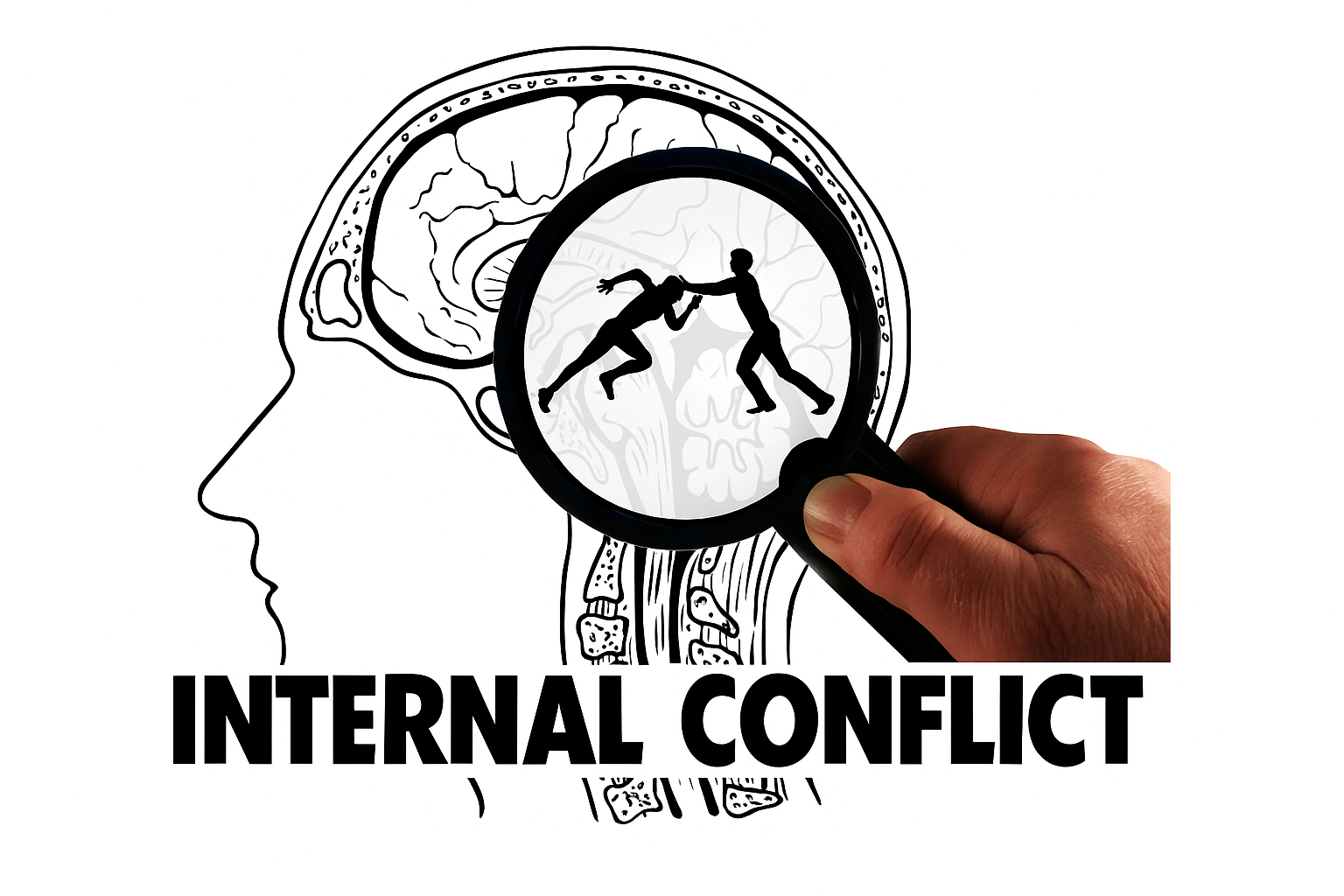Antarvafna: Understanding the Inner Conflict That Drives Transformation
Has it ever seemed like you are experiencing two different parts of you fighting against each other? The first is based on ambition, the second on fear.One chasing passion, the other clinging to comfort. That inner push and pull isn’t just emotional noise—it has a name: Antarvafna.
Rooted in Sanskrit, Antarvafna describes the quiet but strong internal battles that guide our decisions, connections with others and who we are. Rather than something unimportant, it is a genuine psychological process that, when understood, can actually help you grow.
We’ll look at Antarvafna, explain where it comes from, learn how it plays out in daily life and discuss effective ways to work with it. If you live in the UK, the US or some other place, I think this idea will feel very familiar to you.
Antarvafna: What It Really Means and Why It Matters
At its core, Antarvafna blends two Sanskrit roots: antar (inner) and vafna (conflict or battle). Together, they reflect the invisible struggle many of us feel but can’t always name.
This isn’t about the kind of conflict you can see or explain. It’s that low hum of discomfort when your actions don’t align with your values. It’s the inner critic that doubts your dreams right after you’ve set them. It’s also the gut feeling that something’s off—even when everything looks fine on the surface.
Antarvafna is significant because it forces us to confront who we really are beneath social conditioning, expectations, and fear. It encourages introspection, clarity, and, ultimately, change.
Antarvafna in Everyday Life: The Subtle Ways It Shows Up
You don’t need to be in the middle of a major life crisis to feel Antarvafna. In fact, it often shows up in the ordinary:
- Career Choices: That gnawing doubt about staying in a high-paying but unfulfilling job? That’s Antarvafna. It’s your desire for purpose clashing with your need for security.
- Relationships: When you’re torn between staying in a comfortable but stagnant relationship and seeking something more meaningful—that’s Antarvafna again.
- Personal Values vs. Social Pressure: Wanting to live sustainably but struggling with convenience-driven habits? Another classic example.
The beauty of recognising Antarvafna is that it gives you the language to explore your hesitation and tension without labelling yourself as weak or indecisive. It reframes your inner tug-of-war as a signal, not a setback.
Antarvafna: The Psychological Science Behind Inner Conflict
While Antarvafna is steeped in spiritual tradition, psychology backs it up.Inner conflict usually happens when two of the “selves” within a person argue about what decision to make.
There are parts of your brain that like trying new things and taking risks, while parts want comfort and order. Having to deal with many tasks at once might cause anxiety, too much worry or exhaustion. Interestingly, psychologists also think that this conflict supports personal growth.
A lack of tension means growth cannot happen. Without Antarvafna, there’s no evolution.
Antarvafna in Modern Society: Why It’s More Relevant Than Ever
In our hyper-connected, always-on culture, Antarvafna is everywhere.We are constantly fed colorful perfection from social media which could leave us envious, unsure of ourselves or under stress. Seeing what people highlight online and comparing it to our own work life creates pressure in our minds.
It is often difficult for people living in the UK and US because social pressure to succeed and be productive can conflict with what individuals really want to do or feel. The result? Antarvafna turns into a continuous force we almost don’t even notice.
Being aware is very important. It becomes easier to heal when we give it a label.
Antarvafna: Turning Inner Conflict into Personal Power
The goal isn’t to eliminate Antarvafna—that’s impossible. Instead, it’s to work with it. Here’s how:
- Mindful Awareness
Stop when you are uncertain. In what ways are different values clashing? Calling out the source can make the discomfort easier to work with. - Journaling for Clarity
When you write down your ideas, they are less confusing. The tool helps you better listen to Antarvafna. - Meditative Reflection
Taking time to pay attention to your breath or practice mindfulness can lower your inner stress. - Trusted Conversations
From time to time, telling your truth to someone else can make you realize things you did not realize when you wrote. Look for someone to talk to about your ideas, like a friend, mentor or therapist. - Micro-Decisions
It can be very difficult to make decisions when faced with inner conflict relating to major life actions. Instead, make one small decision in the direction of what feels true. Let momentum build gradually.
Remember: Antarvafna isn’t your enemy. It’s your teacher.
Antarvafna and the Journey of Self-Discovery
You won’t always resolve Antarvafna overnight. Sometimes, it lingers. But over time, it becomes a compass, pointing toward who you are becoming.
That anxious feeling before making a bold decision? That’s growth knocking. That frustration with status quo? That’s your potential speaking up.
The people who embrace their Antarvafna are often the ones who evolve most meaningfully. They don’t chase perfection. They chase alignment.
They understand that inner peace isn’t the absence of conflict—it’s the ability to navigate it with wisdom and heart.
Antarvafna in Action: Real-Life Examples of Growth Through Conflict
- Emma, a graphic designer in Manchester, felt torn between freelancing (freedom) and a corporate job (stability). Through journaling and a few low-risk freelance gigs, she eased into full-time self-employment, transforming Antarvafna into a confident new path.
- Jason, a software engineer in Seattle, wrestled with burnout. His Antarvafna showed up as guilt over slowing down versus a desperate need for rest. Therapy helped him reframe rest not as weakness, but as strength. He later became a mental health advocate in tech spaces.
Both of them didn’t run from their inner conflict—they mined it for insight.
Antarvafna: Embrace It, Don’t Erase It
If you take one thing from this, let it be this: your inner conflict doesn’t make you broken—it makes you human. Antarvafna is not a flaw to fix; it’s a doorway to self-awareness, transformation, and ultimately, freedom.
In a world that demands clarity and confidence, it’s brave to sit in the messiness of doubt and duality. Often, those who go through challenges come out more confident, knowledgeable and connected to their authentic selves.
If you ever hesitate or feel confused, focus more on your positive feelings. Listen. Your guiding Antarvafna is helping you get home.
FAQs About Antarvafna
Q1: What definition should we give to the term “Antarvafna”?
It comes from the Sanskrit language, combining antar (inside) and vafna (fight) to describe emotional and mental struggles within us.
Q2: Is Antarvafna a negative experience?
A2: Not necessarily. It can make you feel unsure, but it’s usually showing that you’re prepared to develop or change.
Q3: Can anyone experience Antarvafna?
A3: Absolutely. All people, regardless of their background or job, have faced burnout..
Q4: How can I identify my own Antarvafna?
A4: Pay attention to repeated patterns of indecision, guilt, or anxiety. These are often symptoms of deeper internal conflict.
Q5: Is there a benefit to embracing Antarvafna?
A5:Yes! Dealing with your problems on the inside makes you clearer about yourself and stronger inside.



